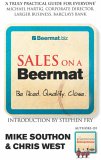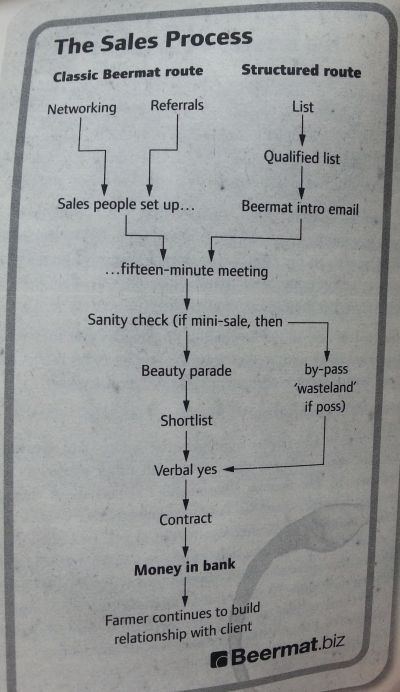Sales On A Beermat 2005 Southon & West
I was really hoping to like this book. Written by Englishmen for someone new to sales, extoling simplicity from the title. Yet I was frustrated. At fifteen quid for 150 pages I was expecting more.
I can’t help thinking the intended audience would be frozen by the formality of the approach. Whilst plain-English is laudable, the insistence of sticking to a tired structure irritated me. The logical running order of the old school funnel approach is nowadays defunct. And definitely so for the breezy style they revel in. I personally don’t want to read another sales book that has bog-standard text-book chapters.
The authors apparently wrote this off the back of their training seminar, showing start-up founders they needn’t be afraid of Sales. Something I too have done. And yes, entrepreneurs are in the main blinkered to all things selling.
So the compilers must recognise the most common barriers. Indeed they mention several real-world roadblocks throughout. I’d have preferred a focus on those. Leave the journalese self-help gee-up waffle to the Americans. And deal with how to tackle the inevitable humps.
Yet within, there were some good points lurking:
Ask yourself first the magic question of ‘where’s the pain’, how to identify your essential ‘customer mentor’, spot buying signal ‘magic words’ (esp. when the prospect says ‘need’ plus ‘now’), avoid professional buyers (they’re never win-win) and know upfront the things that can go wrong on a sale (I liked the reference to being a ‘stalking horse’).
The problem remains that there are too many prescriptions that don’t hold water.
I disagree with the tone of their definition of the real ‘Always-Be-Closing’ ABC. They say it is rather QRTASOSCUTFPC; ”qualify relentlessly through a series of small closes until the final pure close”.
Their “model beermat intro email” does not work. See pic below. It completely ignores any type of problem statement, and the only one they refer to in the explanatory text is never the answer (“we believe we can cut your costs by 25%”).
In the penultimate chapter, ramping up business, there’s this delightful little line to deploy on an existing client;
‘you spend 10k a year with us, what would you pay us 20k a year to do?’
I can hear myself asking this. They hint that;
“The answer is unlikely to be, ‘x’, and here’s the money – but it will get people thinking”
Whilst I like this, I know that focusing on what you want (in this case an extra ten grand in your back pocket) rather than what may help the client, never really gets you anywhere.
Finally, one big plus the book does have is they understand the importance of ‘process’. You must know yours. As I bang on about all the time.
They also show this on a beermat. Albeit one way larger than any I’ve ever seen in a pub.
It is too linear for my tastes as you may know. Less a process, more a kind of timeline without dates. More a traditional funnel description. (& don’t we nod knowingly at the concept of “wasteland”…)
Whether yours follows this or not doesn’t matter so much. You need to know how your ideal sales progress and what always happens on deals when you win.



